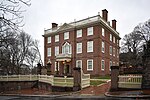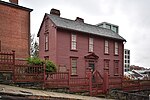Thomas P. Ives House
Historic American Buildings Survey in Rhode IslandHistoric district contributing properties in Rhode IslandHouses completed in 1806Houses in Providence, Rhode IslandHouses on the National Register of Historic Places in Rhode Island ... and 3 more
NRHP infobox with nocatNational Historic Landmarks in Rhode IslandNational Register of Historic Places in Providence, Rhode Island

The Thomas P. Ives House is a National Historic Landmark at 66 Power Street in the College Hill in Providence, Rhode Island. Built in 1803–06, this brick house is an extremely well-preserved and little-altered example of Adamesque-Federal style. The house was built by Caleb Ormsbee, a Providence master builder, for Thomas Poynton Ives, a wealthy merchant. Although two of its principal chambers were redecorated in the 1870s, these alterations were reversed in the 1950s. The house was in Ives family hands for more than 150 years. It was designated a National Historic Landmark on December 30, 1970.
Excerpt from the Wikipedia article Thomas P. Ives House (License: CC BY-SA 3.0, Authors, Images).Thomas P. Ives House
Brown Street, Providence
Geographical coordinates (GPS) Address Nearby Places Show on map
Geographical coordinates (GPS)
| Latitude | Longitude |
|---|---|
| N 41.823333333333 ° | E -71.402777777778 ° |
Address
Brown Street 5
02906 Providence
Rhode Island, United States
Open on Google Maps










